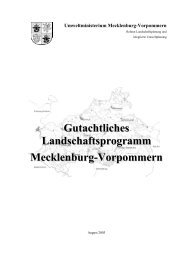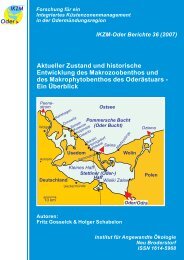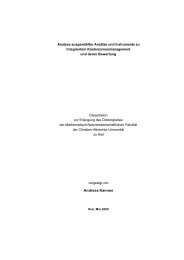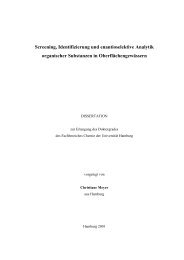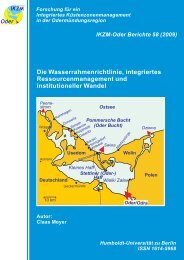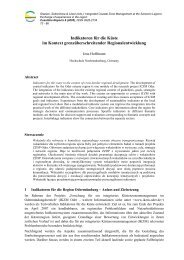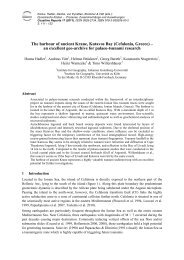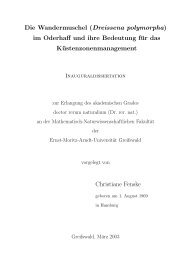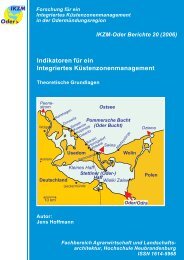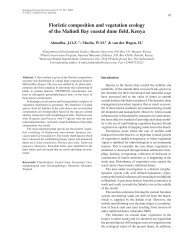The impact of grazing on spider communities in a mesophytic ...
The impact of grazing on spider communities in a mesophytic ...
The impact of grazing on spider communities in a mesophytic ...
Create successful ePaper yourself
Turn your PDF publications into a flip-book with our unique Google optimized e-Paper software.
Discussi<strong>on</strong><br />
- <str<strong>on</strong>g>The</str<strong>on</strong>g> <str<strong>on</strong>g>impact</str<strong>on</strong>g> <str<strong>on</strong>g>of</str<strong>on</strong>g> <str<strong>on</strong>g>graz<strong>in</strong>g</str<strong>on</strong>g> <strong>on</strong> <strong>spider</strong> <strong>communities</strong> <strong>in</strong> a <strong>mesophytic</strong> calcareous dune grasslands - 141<br />
<str<strong>on</strong>g>The</str<strong>on</strong>g>re is a general c<strong>on</strong>sensus that <strong>spider</strong>s are good<br />
ecological <strong>in</strong>dicators (Maelfait & Baert 1988; Rusht<strong>on</strong><br />
1988; Speight 1986; Maelfait et al. 1989). A comm<strong>on</strong>ly<br />
used method for sampl<strong>in</strong>g is pitfall trapp<strong>in</strong>g. Although<br />
this methodology has widely known defects, it is a very<br />
practical way to sample ground active <strong>in</strong>vertebrates.<br />
S<strong>in</strong>ce absolute pitfall catches reflect ma<strong>in</strong>ly animal activity<br />
(for <strong>in</strong>stance ground active species are more frequently<br />
caught than typical species <str<strong>on</strong>g>of</str<strong>on</strong>g> the herb layer)<br />
rather than the animal density (Uetz & Unzicker 1976),<br />
a transformati<strong>on</strong> <str<strong>on</strong>g>of</str<strong>on</strong>g> the data to relative activities (number<br />
<str<strong>on</strong>g>of</str<strong>on</strong>g> species caught per trap divided by the total caught<br />
numbers dur<strong>in</strong>g the sampl<strong>in</strong>g campaign) is necessary to<br />
make comparis<strong>on</strong>s between sampl<strong>in</strong>g stati<strong>on</strong>s, us<strong>in</strong>g<br />
species with different activity characteristics. Merrett<br />
(1983) showed that even <strong>in</strong> complex vegetati<strong>on</strong> structures,<br />
the <strong>spider</strong> community compositi<strong>on</strong> obta<strong>in</strong>ed by<br />
pitfall catches (transformed to relative abundance) was<br />
broadly similar to those obta<strong>in</strong>ed by absolute methods<br />
such as D-vacuum sucti<strong>on</strong> sampl<strong>in</strong>g. By the applicati<strong>on</strong><br />
<str<strong>on</strong>g>of</str<strong>on</strong>g> the latter sampl<strong>in</strong>g technique, absolute species numbers<br />
are obta<strong>in</strong>ed which reflect the actual <strong>spider</strong> densities<br />
<strong>in</strong> the field.<br />
Although we sampled dur<strong>in</strong>g two different periods,<br />
earlier research revealed that the (dom<strong>in</strong>ant) <strong>spider</strong> community<br />
compositi<strong>on</strong> <str<strong>on</strong>g>of</str<strong>on</strong>g> stable envir<strong>on</strong>ments (heathlands,<br />
grassland systems, shrubs, woodlands; Baert & Desender<br />
1996; T<str<strong>on</strong>g>of</str<strong>on</strong>g>t pers. comm.) rema<strong>in</strong>s similar from year to<br />
year. On the other hand, the compositi<strong>on</strong> <str<strong>on</strong>g>of</str<strong>on</strong>g> <strong>spider</strong><br />
<strong>communities</strong> <strong>in</strong> highly dynamic systems (Ammophila<br />
dunes, <strong>in</strong>undated dune slacks) can undergo str<strong>on</strong>g temporal<br />
fluctuati<strong>on</strong>s, ma<strong>in</strong>ly due to changes <strong>in</strong> the density<br />
<str<strong>on</strong>g>of</str<strong>on</strong>g> typical and dom<strong>in</strong>ant opportunistic species (typical <str<strong>on</strong>g>of</str<strong>on</strong>g><br />
highly disturbed envir<strong>on</strong>ments). <str<strong>on</strong>g>The</str<strong>on</strong>g>ir col<strong>on</strong>izati<strong>on</strong> is<br />
dependent <strong>on</strong> favourable weather circumstances s<strong>in</strong>ce<br />
they disperse ma<strong>in</strong>ly via ‘ballo<strong>on</strong><strong>in</strong>g’ (Richter 1970;<br />
B<strong>on</strong>te et al. 1998). This ‘ballo<strong>on</strong><strong>in</strong>g’ or aer<strong>on</strong>autic behaviour<br />
is a passive aerial dispersal <str<strong>on</strong>g>of</str<strong>on</strong>g> <strong>spider</strong>s; attached<br />
<strong>on</strong> a l<strong>on</strong>g sp<strong>in</strong>neret thread they are transported with<br />
moderate air currents <strong>on</strong> warm, dry days.<br />
<str<strong>on</strong>g>The</str<strong>on</strong>g> TWINSPAN- and MDS-analyses clearly reveal<br />
<strong>spider</strong> assemblages that differ between the grazed and<br />
ungrazed sites, al<strong>on</strong>g a more or less c<strong>on</strong>t<strong>in</strong>uous gradient<br />
from heavily grazed vegetati<strong>on</strong> without nearby rough<br />
vegetati<strong>on</strong>, through the transiti<strong>on</strong> z<strong>on</strong>e between the areas<br />
to the ungrazed and rough vegetati<strong>on</strong>. <str<strong>on</strong>g>The</str<strong>on</strong>g> coupl<strong>in</strong>g<br />
<str<strong>on</strong>g>of</str<strong>on</strong>g> the species data to the envir<strong>on</strong>mental data set with the<br />
PRIMER s<str<strong>on</strong>g>of</str<strong>on</strong>g>tware shows the community determ<strong>in</strong><strong>in</strong>g<br />
variables. Cattle <str<strong>on</strong>g>graz<strong>in</strong>g</str<strong>on</strong>g> dur<strong>in</strong>g the grow<strong>in</strong>g seas<strong>on</strong> (i.e.<br />
summer) directly <strong>in</strong>fluences the grass and herb layer,<br />
and the presence <str<strong>on</strong>g>of</str<strong>on</strong>g> the dwarf shrub Rosa pimp<strong>in</strong>ellifolia.<br />
<str<strong>on</strong>g>The</str<strong>on</strong>g> tall grass layer and the dwarf shrub layer are both<br />
Fig. 2. Mean species richness and standard deviati<strong>on</strong>s <strong>in</strong> the<br />
five sample stati<strong>on</strong>s (see Table 1), after standardisati<strong>on</strong> to<br />
number <str<strong>on</strong>g>of</str<strong>on</strong>g> species per 100 <strong>in</strong>dividuals.<br />
absent from the cattle-grazed area. Rabbit <str<strong>on</strong>g>graz<strong>in</strong>g</str<strong>on</strong>g> ma<strong>in</strong>ly<br />
affects the grass layer <strong>in</strong> the cattle excluded z<strong>on</strong>es. It<br />
results <strong>in</strong> patchy vegetati<strong>on</strong> with alternati<strong>on</strong> <str<strong>on</strong>g>of</str<strong>on</strong>g> tall<br />
grasses, Rosa pimp<strong>in</strong>ellifolia and low dune grassland<br />
similar to the cattle-grazed situati<strong>on</strong>. <str<strong>on</strong>g>The</str<strong>on</strong>g> last determ<strong>in</strong><strong>in</strong>g<br />
factor is ‘distance from rough vegetati<strong>on</strong>’, which is<br />
resp<strong>on</strong>sible for differences <strong>in</strong> <strong>spider</strong> <strong>communities</strong> and<br />
total catch numbers. <str<strong>on</strong>g>The</str<strong>on</strong>g>se results are <strong>in</strong> agreement with<br />
the results <str<strong>on</strong>g>of</str<strong>on</strong>g> other authors who have <strong>in</strong>vestigated <strong>spider</strong><br />
<strong>communities</strong> <strong>in</strong> relati<strong>on</strong> to vegetati<strong>on</strong> structure (Rusht<strong>on</strong><br />
1988; Maelfait et al. 1990; Gibs<strong>on</strong> et al. 1992; Mc<br />
Ferran et al. 1994; Maelfait et al. 1997).<br />
Fig. 3. Activity patterns <str<strong>on</strong>g>of</str<strong>on</strong>g> the Lycosid <strong>spider</strong> Pardosa<br />
m<strong>on</strong>ticola <strong>in</strong> the gradient stati<strong>on</strong>s B, A1 and A2 (n = number <str<strong>on</strong>g>of</str<strong>on</strong>g><br />
<strong>in</strong>dividuals per treatment).



